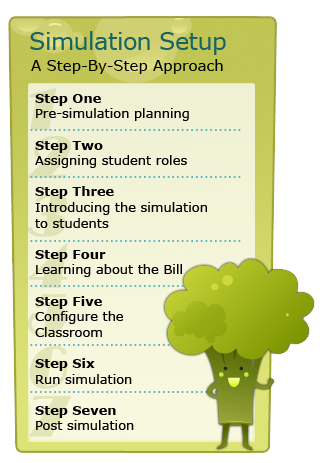
The Vegetable Harmony Act is best suited for use with upper-elementary and middle-school students, but can be adapted to secondary students.
Decide how much time you can devote to the simulation and how much background your students will require, and then select activities accordingly. The regular version of each simulation requires approximately one 75-minute session for preparation and one 75-minute session to conduct the simulation itself. Sidebar instructions describe how the simulation may be elaborated at each stage, with estimated times. Debriefing activities may be conducted in a subsequent session or for homework.
Using the following lists, select and reproduce the appropriate number of copies of student materials from the student resources:
Vegetable Harmony Act
Copy of bill to be debated
Role Cards
Role cards that provide detailed character profiles for students to represent, requiring that students grapple with competing personal, party and constituent interests.
Preparing Your Role
Tips and strategies for getting inside the assigned role by considering the bill from the character’s perspective (for modified version click here)
Simulation Procedures and Order of Business
Schedule and instructions for participating in the simulation (for modified version click here)
Clerk Instructions
Annotated script for Clerk on what to do and say in carrying out his/her role
Chair Instructions
Annotated script for Chair on what to do and say in carrying out his/her role
Minister and Witness Materials
Script and information for students playing minister or witness roles
Presenting to the Committee
Questions designed to allow students to understand the presentation notes they will use when speaking to the committee (for modified version click here)
Amendment Proposal Form
A template for students to use when drafting their own amendments
Preparing a Media Report
Preparation work that press-gallery journalists perform prior to a committee meeting (for modified version click here)
Reflecting on the Simulation
Reflecting on the lessons learned through participation in the simulation (for modified version click here)
Assessing the Performance
An assessment rubric for student and teacher to use to assess student preparation, understanding and role portrayal
Developing Effective Questions and Counter-arguments
Strategies and activities to enhance preparation of committee members in asking powerful questions and providing counter-arguments
Simulation Procedures and Order and Business
A format and schedule to use with an elaborated simulation
Preparing to Address the Committee
Minister and witnesses plan their own presentations from independent research and without support of provided notes
Revising Your Views
Activity for students to use information gathered from the initial phase of the committee meeting to revise their preliminary opinions strategy
